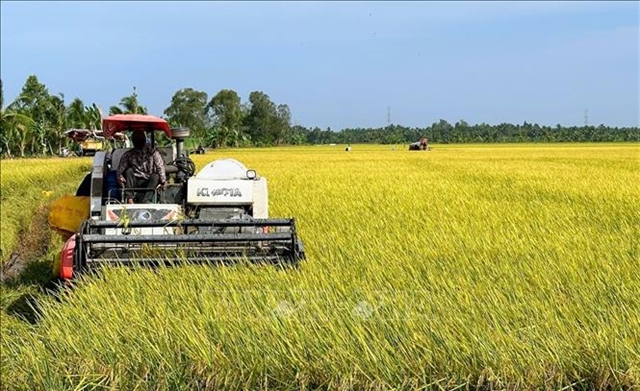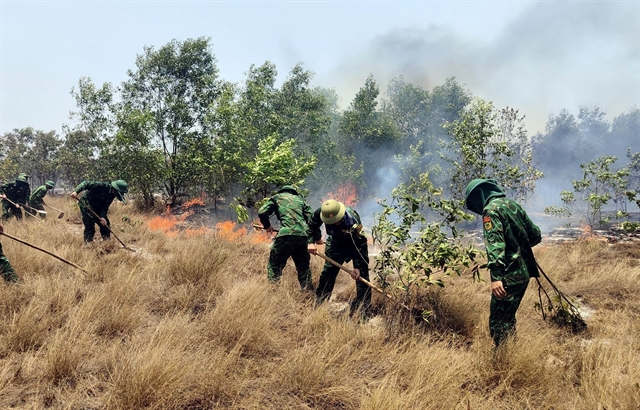 Society
Society

Hoa mai and hoa đào, one yellow and the other pink, are without doubt the two most important, auspicious flowers in Việt Nam.
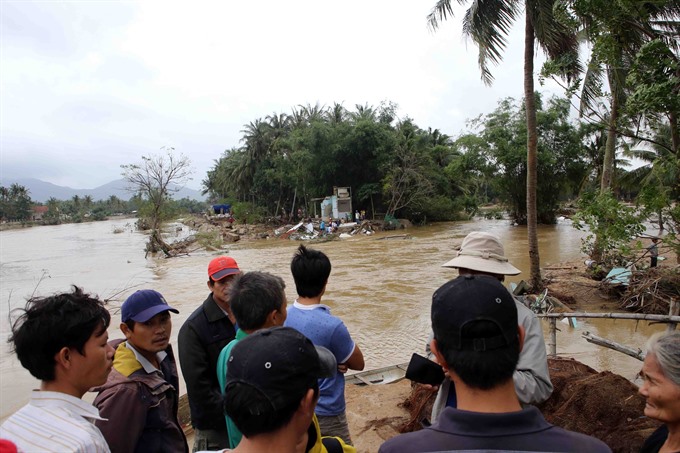 |
| On December 18, after a part of the flood control embankment collapsed, the deluge in Lương Thái Village, Mỹ Chánh Commune, Phù Mỹ District, washed away three houses and multiple local people’s possessions. Floodwaters are gradually receding from residential areas of Bình Định Province. - VNA/VNS Trần Lê Lâm |
BÌNH ĐỊNH – Hoa mai and hoa đào, one yellow and the other pink, are without doubt the two most important, auspicious flowers in Việt Nam.
Come the most important occasion of the year, Tết, the Lunar New Year festival, and these flowers are a must in just about every Vietnamese house, the yellow ones favoured in some regions and the pink ones in others.
These flowers are believed to herald a lucky year.
For many farmers in the central region, these flowers, ochna integerrima (sometimes called the Vietnamese Mickey Mouse) and peach blossoms, are particularly lucky, because they provide a seasonal income that covers up for the whole year.
This year, however, the flowers haven’t been allowed to pull their weight.
Nguyễn Sơn Kề and his family earn their livelihood by growing bonsai mai in Hảo Đức Village, Nhơn An Commune, Bình Định Province.
At noon last Sunday, the floodwaters haven’t receded completely from the village, but Kề, his wife and two children have returned after being evacuated.
They lose no time in caring for their bonsai mai garden. The clean-up of their living space can wait.
The muck and rubbish that covers the mai branches must be washed off – gently, but as quickly as possible – since the mud left to dry under the sun would cause the trees’ leaves to fall off. The result, premature blossoms, is undesirable.
Kề’s family owns some 2,000 bonsai mai pots of trees 3-5 years old.
Usually, at this time of the year, he and other growers in the region would have started selling the trees to traders from both northern and the southern provinces.
“The whole year we’ve cared for the trees, waiting to sell them for Tết. It’s our main source of income, bringing about VNĐ100 million (US$4,400). This year, with repeated flooding, they’ve been submerged for far too long in the waters. They’re as good as gone,” an upset Kề told the Tuổi Trẻ (Youth) newspaper.
Cáp Thị Tuyết Trang, 36, also of Nhơn An Commune, earns a few hundred million đồng every year from the mai trees – enough to cover living expenses for much of the year, and especially, enjoy an ‘abundant’ Tết. Those hopes have been dashed.
Nguyễn Văn Hùng, from Thiện Thái Village, estimates the roots of 30 per cent of his 2,500 mai trees have rotted and the rest face heightened risks of leaf loss.
Nguyễn Tấn Đức, Chairman of the Nhơn An, said 1,700 households in five of the commune’s six villages grow a few millions mai trees, amply supply for the Tết season to many provinces.
“Every year, mai growers can earn some VNĐ18 billion ($790,000). This year, however, about10 per cent of mai trees have died, another 70 per cent cannot be sold, for various reasons.”
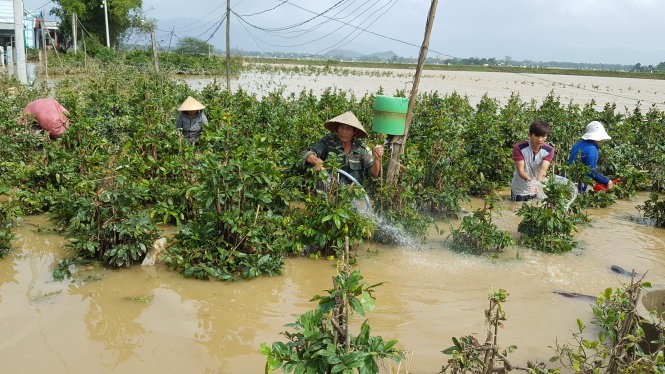 |
| Nguyễn Sơn Kề and his family, in An Nhơn Commune of the central province of Bình Định, are trying to clean the bonson mai garden still deeply submerged in the floodwater on December 17. - Photo tuoitre.vn |
The serial flooding has also damaged flower crops in Phú Mậu Commune in the Hương River Basin. The commune is an important supplier of flowers to Huế City for Tết.
“This is terrible, it’s one thing to not have a proper celebration of the New Year, it’s another to not be able to repay loans for seedling and fertiliser,” said a worried Phan Văn Mai.
He expected to sell the 10,000 chrysanthemum plants he planted nearly two months ago for a seasonal profit of VNĐ20 million ($880), but that looks to be unlikely this year.
Trần Hữu Cơ, Phú Mậu People’s Committee Chairman, said 13ha of farmland in the commune is used to grow flowers for Tết, but the floods have damaged all the cultivation area, leaving hundreds of households not only empty-handed but also potentially mired in debt.
A proper survey hasn’t been conducted, but a majority of 245ha of flower gardens were badly damaged by the unexpected floods, said Hồ Vang, Deputy Director of the Thừa Thiên – Huế Province’s Department of Environment and Natural Resources.
Tư Nghĩa District in Quảng Ngãi Province, one of the largest chrysanthemum suppliers in the central region, is devastated. Nearly all the flower farms on the Vệ River bank completely damaged.
Dispirited farmers have not been able to summon the energy to remove the flower pots that lie lifeless, everywhere.
During the first flooding, they tried to save the flowers by moving them to higher ground, but around 100,000 chrysanthemum pots didn’t make it. The latest round recent destroyed another 300,000 pots.
Lê Trung Thành, Tư Nghĩa People’s Committee Chairman, approximates the damage at over VNĐ30 billion ($1.32 million).
The recent floods also damaged 2,500ha of vegetables in Đại Lộc District, Quảng Nam Province, increasing the VNĐ12 billion ($527,000) damage inflicted by previous rounds.
Local authorities have requested financial support from the government for the farmers to buy seedlings and resume agricultural production soon.
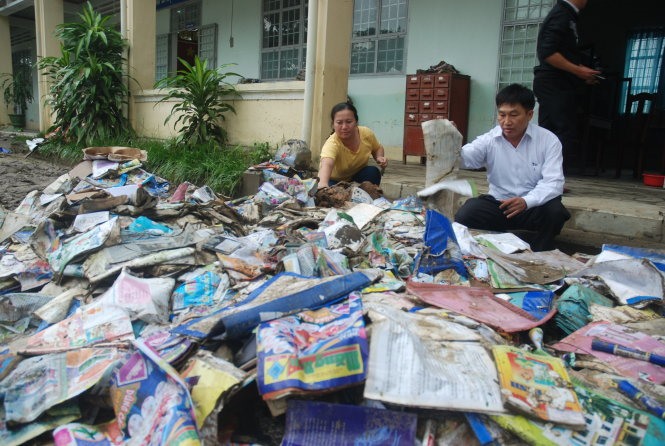 |
| Nguyễn Bá Hậu (right), Headmaster of the Cát Tài No.2 Primary School in Phù Cát District, Bình Định Province, and the deputy headmaster, are trying to sort out the soggy books. In the recent floods, nearly all the documents, records, and school appliances of the school have sustained water damages beyond repairs. — Photo tuoitre.vn |
Many schools in Bình Định Province have been hit hard by the floods and are unable to open though final examinations are just around the corner.
Nguyễn Thị Bích Hải, Headmaster of the Cát Trinh No.1 Primary School in Phù Mỹ District, and seven teachers have been trying to clean up the classrooms, but sorting out the soggy, mud-covered books and soaked furniture takes a lot of efforts.
“We started cleaning up over the weekend, as soon as the waters receded, hoping to reopen the school on Monday, but it’s just too much.”
The unexpected flooding took everyone by surprise. Lesson plans, documents and other records, and most of the school properties have been lost or damaged.
Ceiling fans have been running at max speed to dry water-logged computers and other electronic devices in the slim hope that at least a few can be salvaged.
“The school closed for 10 days. Evacuation after evacuation has disrupted learning. Without more classes, they won’t be able to take the finals comfortably,” said Đỗ Minh Châu, Deputy Headmaster of the Cát Tài No.2 Primary School in Phù Cát District.
Teachers and students of Nhơn Hoà No.2 Primary School in An Nhơn Commune face a different difficulty. Floodwaters spared the school, but the path leading to the school is still inundated by overflowing streams.
Đào Đức Tuấn, Director of the provincial Department of Education and Training, said 8 students have died, 50,000 students have lost their school supplies and books, 2,000 computers and thousands of tables and chairs and other possessions have been damaged. Estimated loss reaches upwards of VNĐ31 billion ($1.36 million).
The department has directed the schools to delay examinations by a week and organise extra classes so students can catch up.
Hồ Quốc Dũng, Bình Định Province People’s Committee Chairman, has requested the Minister of Education and Training, Phùng Xuân Nhạ, to support the province with textbooks, notebooks and other school supplies.
He has also proposed to the Prime Minister that tuition fees are waived for all students in the province for the second term.
“After consecutive flooding, many households are exhausted. They have no money left for their children’s schooling,” Dũng said. – VNS

